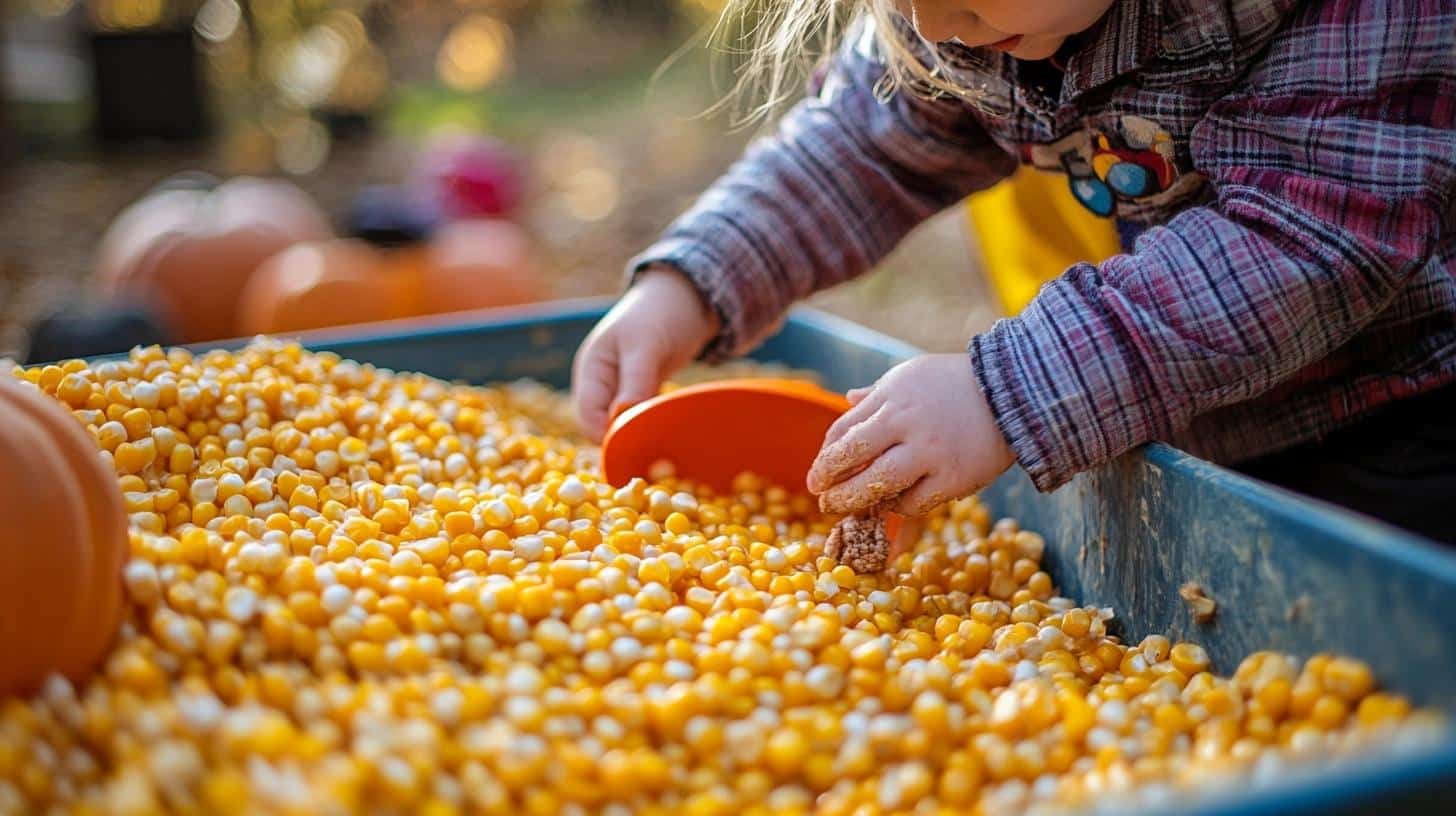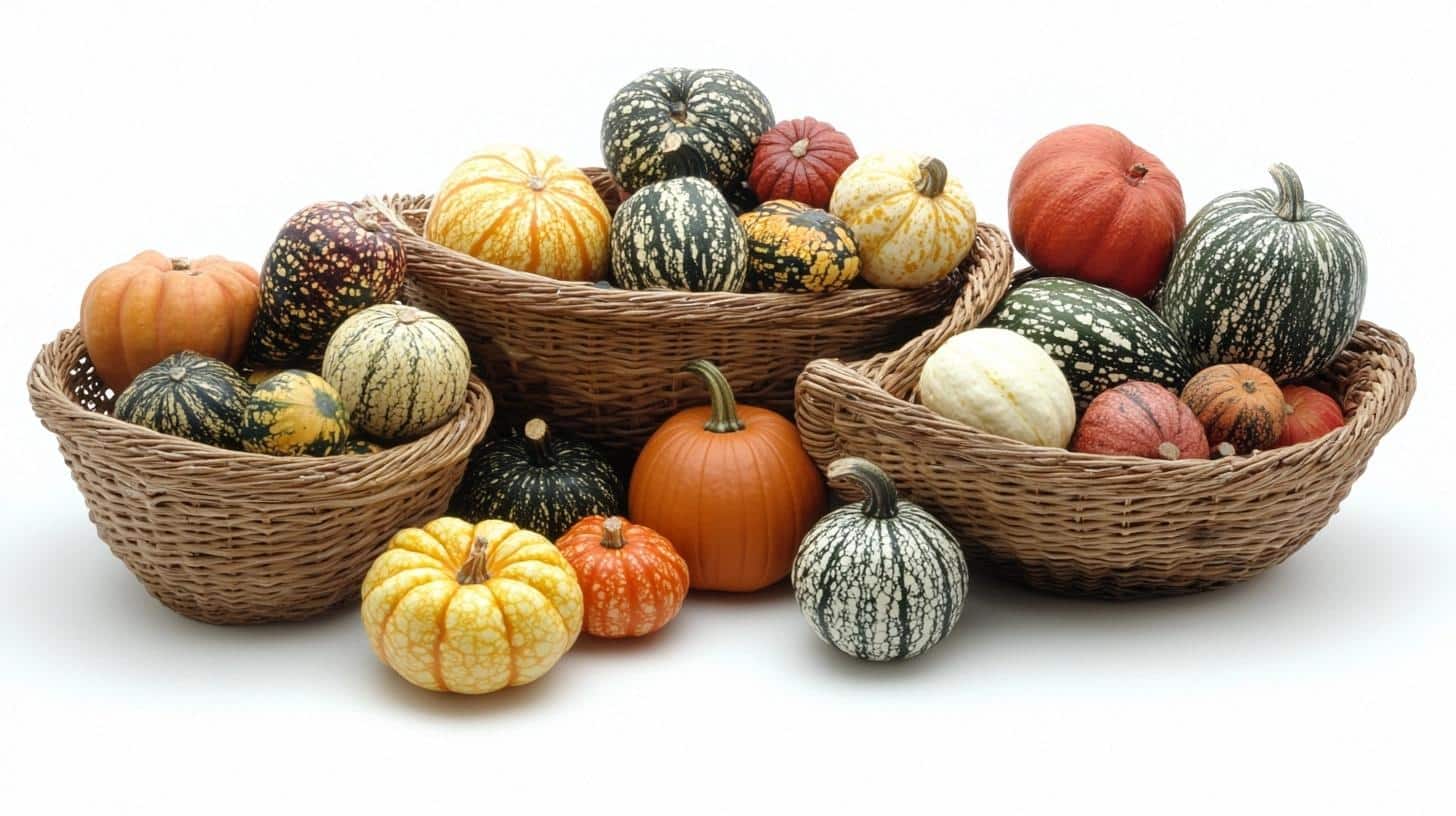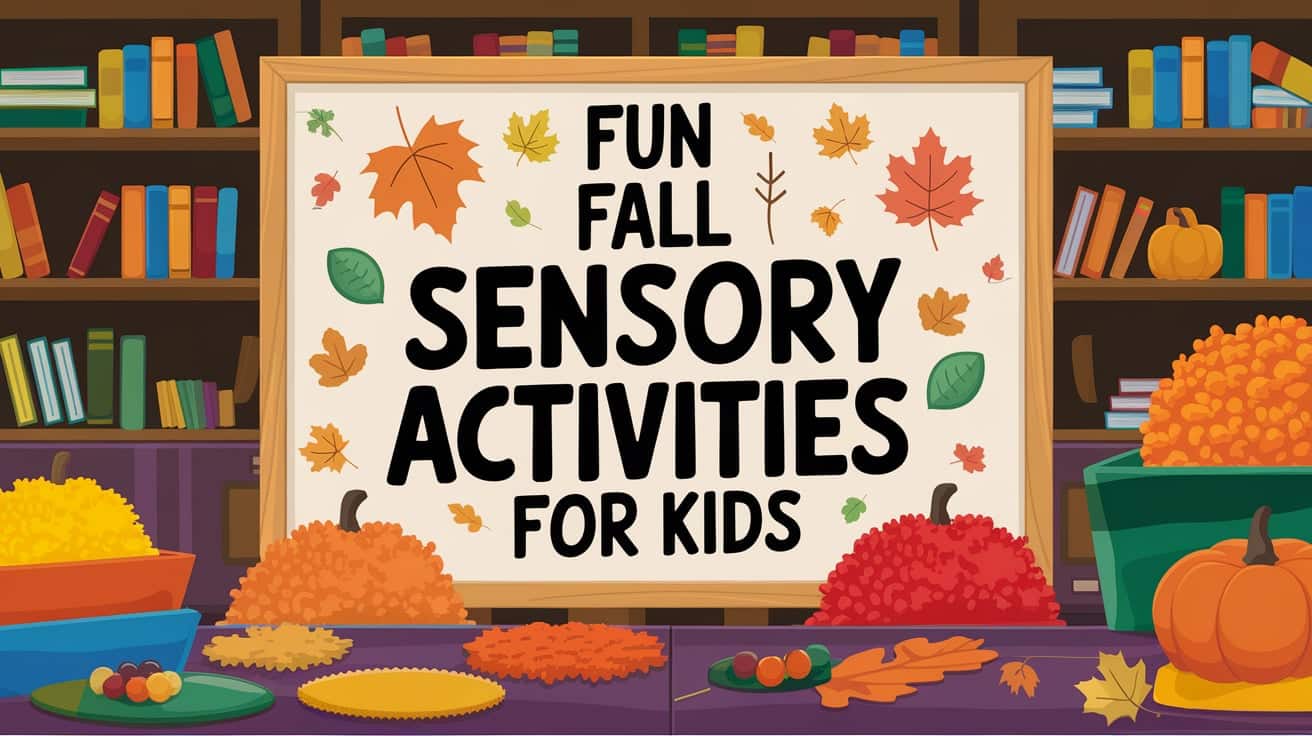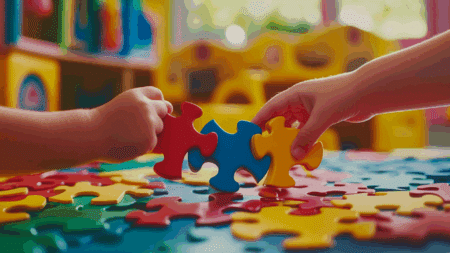Fall is a season filled with crisp air, colorful leaves, and cozy feelings! Fall sensory activities bring all these wonderful autumn experiences right to your child’s fingertips.
These simple activities create learning moments as children finds different textures. When kids dig, pour, and play with these seasonal items, they’re actually building important skills while having fun. These hands-on experiences help improve fine motor skills, language development, and real-life thinking. Plus, they’re just plain fun!
The best part about fall sensory bins is how easy they are to create! You can gather materials from your own backyard, local park, or grocery store.
In this blog, we’ll give you simple ideas for creating fall-themed sensory bins that have the beauty of autumn in ways your children will love.
Why Sensory Activities are Perfect for Toddlers and Preschoolers
When kids play with fall items like leaves, acorns, and pumpkin seeds, they use their hands in new ways. This builds the small muscles they need for writing and other skills.
Sensory play also teaches children about their world. By feeling different fall objects, they learn words like “crunchy,” “smooth,” and “bumpy.” This builds their speaking skills. A child who plays with pine cones, corn husks, and smooth chestnuts learns to name and describe these items.
They help kids learn to focus. When the kids sort colored leaves or find hidden objects in corn kernels, they practice paying attention. The more interesting the bin, the longer they will stay engaged.
These activities also calm children. The feeling of running fingers through beans or rice can help kids who feel worried or upset. Playing with others in a sensory bin teaches sharing and taking turns. Children learn to work together and make friends.
Best of all, fall sensory bins are easy to make at home. You can use simple items you already have or find outside. This makes learning fun without spending much money.
Fall Sensory Activity Ideas
These hands-on fall activities engage multiple senses, helping children learn through play while enjoying the special sights, smells, and textures of autumn. Each activity is simple to set up with items you likely have at home.
1. Pumpkin Spice Cloud Dough

This soft dough smells like fall and feels amazing to touch.
Mix 8 cups of flour with 1 cup of oil and 2-3 spoons of pumpkin-pie spice. Stir until it feels like soft sand that can be molded. Kids love to squeeze, shape, and mold this dough into mountains or pretend cookies. The fall smell makes it extra special and creates a cozy autumn feeling.
Add small cookie cutters shaped like leaves or pumpkins for more creative play. Small plastic animals can make tracks in the dough, too. Store it in a closed container to use again later – it stays fresh for weeks!
This play helps small hand muscles grow stronger as children pinch, roll, and flatten the dough. The nice smell can also help calm busy kids, making it perfect for after-school wind-down time.
2. Apple Cider Sensory Bin

This bin lets kids explore with their hands and noses while learning about fall scents.
Fill a plastic bin with 4 cups of water and 1 cup of apple cider vinegar for a gentle apple smell. Add dried apple slices, cinnamon sticks, and star anise for both texture and scent. Put in cups, spoons, funnels, and small pitchers for pouring practice.
Kids love to pour and mix the scented water from container to container. The dried apples get soft over time, which shows kids how things can change with water. Children can pretend to make apple cider or soup as they play.
This sensory bin teaches kids about liquids, measuring, and pouring skills. With each pour, they practice hand-eye coordination. The apple smell makes it feel like fall and creates memories of autumn baking.
3. Leaf Rubbing Art

Go outside to collect different fall leaves with your child. Look for leaves with strong veins and interesting shapes. Once back inside, place a leaf under the thin paper with the vein side facing up. Rub the side of an unwrapped crayon over the paper, using fall colors like red, orange, and yellow.
Watch the leaf pattern magically appear! Kids are amazed to see the leaf’s lines show up on paper. They can make multiple leaf rubbings on one page for a collage effect.
Try different leaves to compare patterns.
Children learn to notice small details in nature as they see the unique structure of each leaf. The finished art makes great cards, placemats for Thanksgiving, or refrigerator decorations.
4. Acorn Sorting Activity

Acorns make learning math fun and hands-on while connecting children to nature.
Collect 20-30 acorns from outside during a fall nature walk. Look for different sizes, colors, and ones with and without caps. Provide small bowls, egg cartons, or muffin tins for sorting containers.
Let kids sort acorns by size (small, medium, large), color (light brown, dark brown), if they have caps, or how smooth they are. Children can also count groups or make patterns with the acorns.
This simple activity teaches sorting, grouping, and counting naturally. Kids learn to spot tiny differences between similar objects.
They also practice using words like “bigger,” “smaller,” “rougher,” and “smoother.” When done, the acorns can be used for counting games or saved for craft projects.
5. Corn Kernel Digging Bin

This bin feels wonderful and keeps kids busy for a long time while celebrating fall harvest themes.
Fill a big plastic container with dried corn kernels, which you can buy inexpensively at farm supply stores. The bin should be deep enough for digging but not so deep that it spills easily. Hide small toys, mini pumpkins, plastic spiders, or fall-colored gems throughout the corn.
Add scoops, cups, funnels, and small containers for digging and pouring. Kids love the feeling of corn running through their fingers and the sound it makes when poured. Finding hidden objects is like a treasure hunt that keeps interest high. Children can bury and find objects over and over.
This play builds hand strength as kids dig and scoop. It also develops focus as they search for hidden items. The corn bin can be saved and used many times throughout the fall season. Just keep it dry and covered when not in use.
6. Fall-Themed Sensory Bags

These bags let kids explore fall items without a mess, making them perfect for younger children.
Fill strong zip-top freezer bags with colored rice (dyed orange or red with food coloring), small leaves, mini pinecones, cinnamon sticks, or star anise. Add a few tablespoons of hair gel or clear hand sanitizer to create resistance so that items move slowly.
Seal the bag and cover the entire seal with strong packing tape for extra security. Kids press and squish the bags to move the items inside. They can hunt for hidden objects or just enjoy the sensory experience.
These bags are great for babies or toddlers who might put things in their mouth. They’re also good for places where cleanup needs to be quick, like waiting rooms or car rides.
The bags can be taped to windows to add a light element, or taped to a table for easier play. Fall sensory bags offer visual and tactile input without the mess of direct contact with materials.
7. Gourd Sorting Station

Gourds come in many shapes, sizes, and colors, making them perfect natural toys for fall learning.
Buy small decorative gourds and mini pumpkins from grocery stores or farmers’ markets. Look for variety in colors (orange, green, yellow, striped), shapes (round, long, bumpy), and sizes.
Provide baskets, bowls, or divided trays for sorting containers. Let the kids group the gourds by anything they notice. They might sort by color, shape, size, texture, or weight. Children can also create patterns with the gourds or line them up from smallest to largest.
Kids enjoy handling these interesting fall objects and discovering their unique features. Some gourds are smooth, while others are bumpy; some are heavy, and others are light.
They learn words to describe what they see and feel. The natural differences in gourds help kids think flexibly as they decide how to categorize items that could fit in multiple groups.
8. Apple Stamping

Apples make surprising paint stamps with beautiful patterns that celebrate fall harvest time.
Cut apples in half – some horizontally across the middle to reveal the star pattern of the seeds, others vertically from stem to bottom for a different shape. Pat them dry with paper towels to remove excess moisture. Put fall-colored paints (red, yellow, orange, brown, green) in shallow dishes or paper plates.
Dip apple halves in paint and press them onto paper to create prints. Experiment with different pressures and directions. Kids love seeing the star shape from the apple core appear in their artwork. Add green paint on a small brush to create stems or leaves. Children can make patterns or scenes or just enjoy the process of stamping.
They learn how pressing harder or softer changes the print. This simple art activity connects to fall apple picking and harvest traditions. The finished artwork makes great fall decorations or cards.
9. Cinnamon Stick Sensory Activity

This activity focuses on the wonderful smells of fall and engages the often-overlooked sense of smell.
Gather cinnamon sticks, dried orange slices, whole cloves, star anise, small pinecones, bay leaves, and dried apple chips. Place these items in a shallow tray, basket, or divided container. Let children smell, touch, and explore each item. Talk about which smells are strong, which are sweet, and which they like best.
Kids can sort items by smell strength or personal preference. Older children might create scent mixtures in small cups or sachets using their favorite combinations. Kids enjoy comparing the different scents and textures.
They learn new words to describe smells, such as “spicy,” “sweet,” “strong,” and “mild.” These words can later be used to make simple gifts like potpourri bags or fall decorations for the home.
This sensory play helps children notice and enjoy the special scents of fall while building vocabulary and sensory discrimination skills.
10. Apple Pie Oobleck

This is a fun and messy sensory activity that combines science and fall fun.
To make the oobleck, mix cornstarch and water in a large bowl and add apple pie spices like cinnamon and nutmeg for scent. The mixture will become gooey and thick when touched but will flow like liquid when not being pressed.
It’s a great way to introduce kids to non-Newtonian fluids, which behave differently under pressure.
Kids will love touching this strange substance. It feels solid when you apply pressure but turns to liquid when you stop. This hands-on activity helps children understand cause and effect, and it’s a great way to link fall-themed activities to simple science.
It is messy but highly engaging for sensory exploration.
11. DIY Fall-Themed Sensory Bottle

Fill the bottle with these materials and seal it tightly. Children can shake the bottle and watch how the objects move inside. This creates a soothing experience with sensory play through sight and sound.
This activity is excellent for helping children focus and calm down, as they can observe the movement of the objects inside the bottle.
It’s perfect for quiet play and sensory exploration. Kids can also enjoy learning about the different fall objects inside the bottle, making it a creative way to engage with the season.
12. Corn Husk and Pumpkin Seed Sensory Play

You can shred the corn husks or leave them in their natural state. Add the pumpkin seeds to the mix, and let the children touch, sort, and play with them.
The texture of the husks and seeds will be fun to explore and give kids a chance to develop their fine motor skills.
This activity promotes sorting and organizing, which are essential skills for young kids. Children can compare the different textures of the corn husks and pumpkin seeds.
It’s a simple, hands-on way to explore materials from the fall harvest and is perfect for tactile learning.
13. Falling Leaves Water Play

Kids can watch the leaves float and interact with them by moving them around in the water.
This sensory activity allows children to experience the fall leaves in a new way and helps them explore how different materials behave in water.
The water play aspect of this activity is calming, while the leaves introduce children to nature. Kids can touch, feel, and observe the floating leaves, seeing their textures and how they react to water.
This is a relaxing, interactive experience that connects children to the fall season in a playful, sensory way.
14. Autumn Nature Sensory Walk

Let them touch, smell, and feel the textures of the natural objects they find. Once you return home, the collected items can be used in a sensory bin or for creative play. This activity helps children connect to nature and provides an opportunity to explore seasonal changes.
This walk encourages curiosity and learning as children discover the fall season’s treasures.
It helps develop their observation skills, and they can learn about the different shapes, colors, and textures of natural objects.
It’s a great way to combine physical activity with sensory exploration outdoors.
15. Leaf Pile Jumping

Gather a large pile of leaves in the yard or park, and let the kids jump into it. As they land in the leaves, they will feel the crunch under their feet and hear the rustling sound.
This is a fun and active way for children to engage with the textures of the leaves while burning off energy. Jumping into the pile of leaves is a simple way for kids to experience sensory play with sound, touch, and movement.
It’s an active, enjoyable outdoor activity that’s perfect for fall, and it helps children connect with the season in a fun and physical way.
16. Fallen Leaf Collage

This simple fall art activity lets children create with nature.
Bring your leaf collection inside and let them dry completely if they’re damp. Let children arrange their leaves on the paper before gluing, creating patterns, scenes, or designs. Each leaf has its texture and flexibility, giving rich sensory input.
For added interest, children can include other fall items like small acorns, pieces of pinecone, or tiny twigs. Once completed and dry, these collages make beautiful fall decorations.
This activity develops fine motor skills, encourages scientific observation and promotes artistic mindset – all while creating a memory of the season’s beauty.
17. Crispy Fall Leaf Hunt

This activity encourages children to observe nature and engage their senses as they touch and feel the leaves.
The leaf hunt is a fun, interactive activity that encourages children to explore outdoors. It provides an opportunity to learn about the different kinds of leaves while developing sensory awareness.
The crunching sound of the leaves as children walk through them adds to the sensory experience.
Conclusion
Fall sensory activities help children learn through play in many important ways. They build skills while creating happy memories of the season.
Try a few of these activities to see which ones your child enjoys most. You don’t need fancy materials – many use items from nature or your kitchen.
Watch how your child plays and follow their lead. Some kids love messy activities, while others prefer contained options like sensory bottles or bags.
You can change the activities based on your child’s age and interests. Add more items for older children or simplify for younger ones.
Sensory play should be fun, not stressful. Start with just one bin and enjoy the process together!




